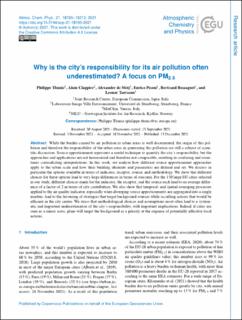| dc.contributor.author | Thunis, Philippe | |
| dc.contributor.author | Clappier, Alain | |
| dc.contributor.author | de Meij, Alexander | |
| dc.contributor.author | Pisoni, Enrico | |
| dc.contributor.author | Bessagnet, Bertrand | |
| dc.contributor.author | Tarrasón, Leonor | |
| dc.date.accessioned | 2022-01-18T11:35:24Z | |
| dc.date.available | 2022-01-18T11:35:24Z | |
| dc.date.created | 2022-01-05T14:06:49Z | |
| dc.date.issued | 2021 | |
| dc.identifier.citation | Atmospheric Chemistry and Physics (ACP). 2021, 21, 18195-18212. | en_US |
| dc.identifier.issn | 1680-7316 | |
| dc.identifier.uri | https://hdl.handle.net/11250/2837907 | |
| dc.description.abstract | While the burden caused by air pollution in urban areas is well documented, the origin of this pollution and therefore the responsibility of the urban areas in generating this pollution are still a subject of scientific discussion. Source apportionment represents a useful technique to quantify the city's responsibility, but the approaches and applications are not harmonized and therefore not comparable, resulting in confusing and sometimes contradicting interpretations. In this work, we analyse how different source apportionment approaches apply to the urban scale and how their building elements and parameters are defined and set. We discuss in particular the options available in terms of indicator, receptor, source, and methodology. We show that different choices for these options lead to very large differences in terms of outcome. For the 150 large EU cities selected in our study, different choices made for the indicator, the receptor, and the source each lead to an average difference of a factor of 2 in terms of city contribution. We also show that temporal- and spatial-averaging processes applied to the air quality indicator, especially when diverging source apportionments are aggregated into a single number, lead to the favouring of strategies that target background sources while occulting actions that would be efficient in the city centre. We stress that methodological choices and assumptions most often lead to a systematic and important underestimation of the city's responsibility, with important implications. Indeed, if cities are seen as a minor actor, plans will target the background as a priority at the expense of potentially effective local actions. | en_US |
| dc.language.iso | eng | en_US |
| dc.rights | Navngivelse 4.0 Internasjonal | * |
| dc.rights.uri | http://creativecommons.org/licenses/by/4.0/deed.no | * |
| dc.title | Why is the city's responsibility for its air pollution often underestimated? A focus on PM2.5 | en_US |
| dc.type | Peer reviewed | en_US |
| dc.type | Journal article | en_US |
| dc.description.version | publishedVersion | en_US |
| dc.rights.holder | © Author(s) 2021. | en_US |
| dc.source.pagenumber | 18195-18212 | en_US |
| dc.source.volume | 21 | en_US |
| dc.source.journal | Atmospheric Chemistry and Physics (ACP) | en_US |
| dc.identifier.doi | 10.5194/acp-21-18195-2021 | |
| dc.identifier.cristin | 1975241 | |
| dc.relation.project | NILU - Norsk institutt for luftforskning: 116002 | en_US |
| cristin.ispublished | true | |
| cristin.fulltext | original | |
| cristin.qualitycode | 2 | |

